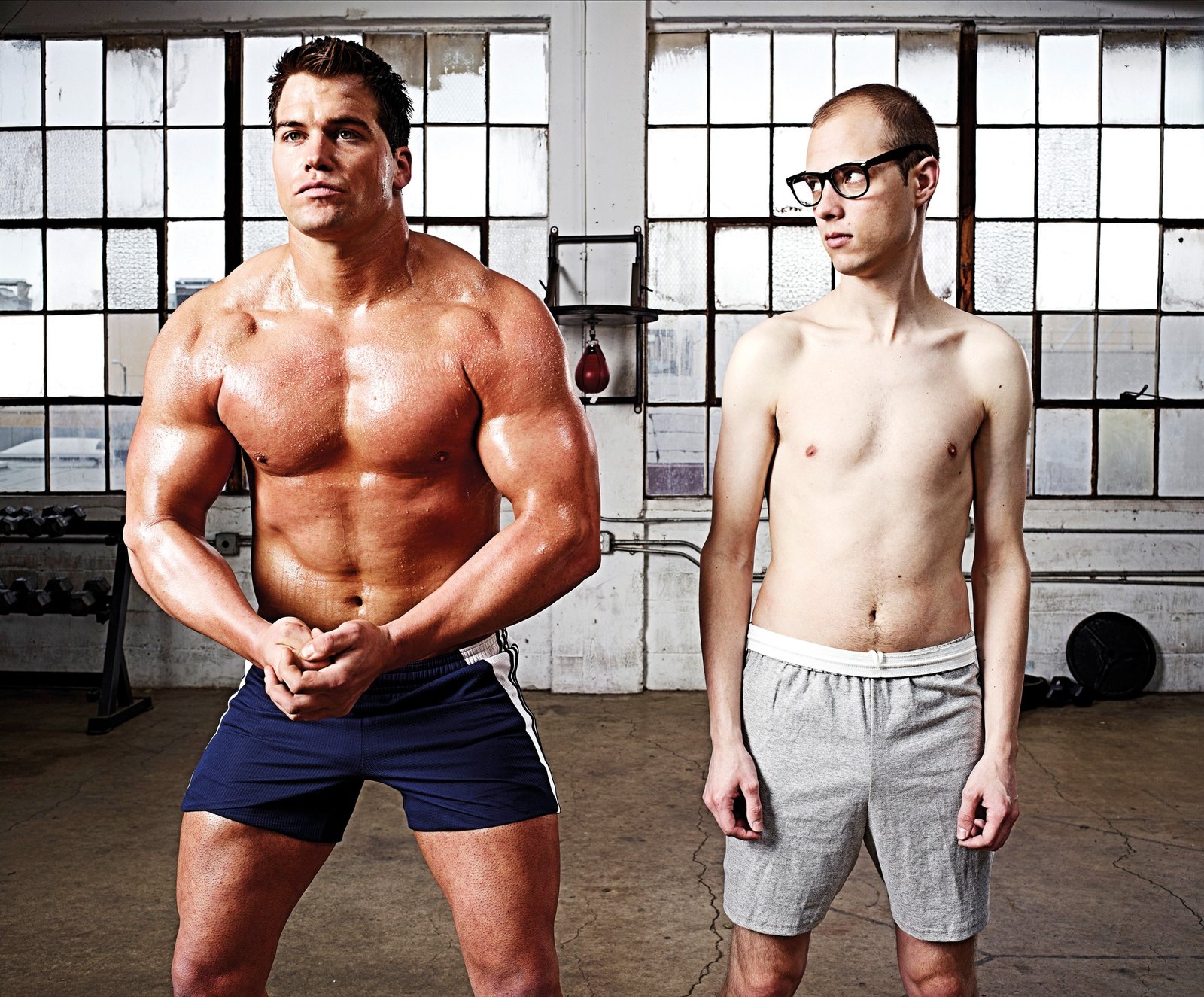Which Statement About American Physical Fitness Best Reflects Current Negative Fitness Attitudes? Current negative attitudes towards American physical fitness are reflected in the statement that a majority of Americans are unfit and overweight. This statement highlights the prevalent perception that physical fitness is not a priority in American society and that many Americans do not prioritize their health.
With the rise of technology and sedentary lifestyles, physical activity has taken a backseat in many people’s lives. This has led to an increase in obesity rates, chronic diseases, and a general decline in overall health. Despite the numerous health benefits associated with regular exercise and physical activity, many Americans continue to struggle with maintaining a healthy lifestyle.
In this blog post, we will explore the current state of physical fitness in America and discuss ways to promote a healthier, more active lifestyle.

Credit: www.slideshare.net
Introduction To American Fitness Perceptions
American physical fitness attitudes have undergone a significant shift in recent years, reflecting a negative perception of fitness and well-being. As such, it is crucial to debunk myths and misconceptions surrounding American physical fitness to gain a better understanding of the current negative attitudes towards fitness.
The Shift In Fitness Culture
The traditional view of physical fitness in American culture has transformed in recent years, reflecting a negative shift in attitudes towards exercise and well-being. The emergence of sedentary lifestyles and the prevalence of technology have contributed to a decline in physical activity, leading to a more pessimistic outlook on fitness and health.
Purpose Of Debunking Myths
Debunking myths and misconceptions about American physical fitness is essential to challenge negative attitudes and promote a more positive and realistic perception of health and well-being. By addressing prevalent misconceptions, we can encourage individuals to adopt healthier lifestyles and overcome the barriers to achieving physical fitness.
The Sedentary Lifestyle Epidemic
The sedentary lifestyle epidemic has led to negative fitness attitudes in America. Many Americans struggle with physical fitness due to a lack of regular exercise and poor dietary habits. This has resulted in a concerning trend of declining physical health and well-being.
Rise Of Desk Jobs
With the rise of technology, many jobs now require sitting in front of a computer for hours on end. This sedentary lifestyle has become the norm for many Americans, leading to negative attitudes towards physical fitness. The convenience of modern technology has made it easy for people to avoid physical activity, leading to a decrease in overall fitness levels.
Impact Of Technology On Activity Levels
The impact of technology on physical activity levels is undeniable. With the rise of smartphones, people are spending more time on their devices and less time being active. This has led to a decrease in overall fitness levels and an increase in negative attitudes towards physical fitness. The ease of access to entertainment and information through technology has made it easy for people to avoid physical activity, leading to a sedentary lifestyle.
The sedentary lifestyle epidemic is a major problem in America, leading to negative attitudes towards physical fitness. With the rise of desk jobs and the impact of technology on activity levels, it has become increasingly difficult for people to maintain a healthy lifestyle. To combat this epidemic, it is important for individuals to make a conscious effort to incorporate physical activity into their daily routines. Small changes such as taking breaks to stretch or going for a walk during lunch can make a big difference in overall fitness levels.
Popular Misconceptions About Fitness
One common misconception about fitness is the belief that being slim equates to being fit. This negative attitude overlooks the importance of overall health and strength. It’s essential to shift the focus from appearance to holistic well-being when discussing American physical fitness.
When it comes to physical fitness, there are several popular misconceptions that contribute to negative attitudes towards maintaining a healthy lifestyle. These misconceptions often deter individuals from pursuing fitness goals, leading to a sedentary lifestyle and a decline in overall well-being. By debunking these myths, we can encourage people to adopt a more positive mindset towards fitness and prioritize their health.
Myth: Exercise Is Time-consuming
Contrary to popular belief, exercise doesn’t have to be a time-consuming endeavor. Many people assume that getting fit requires spending hours at the gym or dedicating long chunks of time to workout routines. However, even short bursts of physical activity can make a significant difference in improving fitness levels.
Instead of focusing on long workout sessions, individuals can incorporate small doses of exercise into their daily routine. This can include taking the stairs instead of the elevator, going for a brisk walk during lunch breaks, or doing quick bodyweight exercises at home. By breaking down exercise into manageable chunks, it becomes more accessible and less overwhelming for those with busy schedules.
Myth: Fitness Requires A Gym Membership
Another common misconception is the belief that fitness can only be achieved through a gym membership. While gyms provide access to a wide range of equipment and fitness classes, they are not the only option for staying active. In fact, many effective workouts can be done without any specialized equipment or a gym membership.
There are numerous alternatives to a traditional gym setting, such as outdoor activities like running, cycling, or hiking. Additionally, bodyweight exercises like push-ups, squats, and planks can be performed at home or in a local park. Online workout videos and mobile apps also offer a variety of guided exercise routines that can be done from the comfort of one’s own home.
By dispelling the notion that fitness is synonymous with a gym membership, individuals can discover affordable and convenient ways to incorporate exercise into their daily lives.
Diet Fads And Their Influence
American physical fitness attitudes are currently influenced by various diet fads. These trends often promote quick fixes and unrealistic expectations, leading to negative attitudes towards fitness. It is important to approach fitness with a balanced and sustainable mindset to achieve long-term health and well-being.
Quick-fix Diets Vs. Sustainable Nutrition
When it comes to diet fads and their influence on American physical fitness, one of the most prevalent negative attitudes is the preference for quick-fix diets over sustainable nutrition. In today’s fast-paced society, many individuals are constantly seeking instant results and are easily swayed by promises of rapid weight loss or miraculous transformations.
This mindset has led to the rise of countless diet fads that promise quick and easy solutions, such as crash diets, juice cleanses, and extreme calorie restrictions. These diets often focus on short-term goals, disregarding the long-term effects on overall health and well-being.
While these quick-fix diets may yield temporary weight loss, they are not sustainable or conducive to maintaining a healthy lifestyle. They often neglect the importance of balanced nutrition, depriving the body of essential nutrients and leading to potential health risks.
On the other hand, sustainable nutrition emphasizes the importance of nourishing the body with a well-rounded diet that includes a variety of whole foods, such as fruits, vegetables, lean proteins, and whole grains. It focuses on long-term health and aims to create sustainable habits that can be maintained over time.
By adopting sustainable nutrition practices, individuals can develop a positive relationship with food and enjoy a more balanced approach to eating. This includes practicing portion control, listening to hunger and fullness cues, and incorporating regular physical activity into their daily routine.
Social Media And Diet Trends
In today’s digital age, social media plays a significant role in shaping diet trends and influencing American physical fitness attitudes. Platforms like Instagram, TikTok, and YouTube are filled with influencers and celebrities promoting various diets and weight loss strategies.
This constant exposure to curated images and success stories can lead to unrealistic expectations and a distorted perception of what it means to be physically fit. Many individuals feel pressured to adhere to the latest diet trends in order to achieve the same level of success or attractiveness portrayed online.
Social media platforms also provide a breeding ground for misinformation and the spread of unregulated diet advice. It can be challenging for individuals to differentiate between evidence-based nutrition information and mere marketing tactics.
It is crucial for individuals to approach social media with a critical mindset and seek guidance from qualified professionals, such as registered dietitians or certified fitness trainers. By relying on credible sources, individuals can make informed decisions about their diet and fitness choices.
The Intimidation Factor In Fitness
When it comes to physical fitness, one of the most significant barriers for many individuals is the intimidation factor. This can be particularly daunting for those who are new to exercise or have taken a hiatus from their fitness routine. Overcoming this intimidation factor is crucial for fostering a positive attitude towards physical activity and promoting a healthier society.
Fear Of Judgment At The Gym
Many people experience a fear of judgment when entering a gym or fitness facility. The concern about not being in the best shape or not knowing how to use the equipment can be overwhelming. This fear of judgment often leads to avoidance of fitness environments, hindering individuals from pursuing their health and wellness goals.
Overcoming The Barrier To Start Exercising
To overcome the intimidation factor and start exercising, it’s essential to focus on personal goals and progress rather than comparing oneself to others. Finding a supportive workout environment, such as a beginner-friendly fitness class or a welcoming gym community, can help alleviate fears of judgment and create a more positive exercise experience. Additionally, seeking guidance from a fitness professional or personal trainer can provide the knowledge and confidence needed to begin a fitness journey.

Credit: www.theguardian.com
The Role Of Media In Shaping Fitness Attitudes
The Role of Media in Shaping Fitness Attitudes
Advertising Unrealistic Body Standards
Advertisements often promote unrealistic body standards, portraying unattainable physiques as the ideal. These images can lead to negative body image and self-esteem issues, especially among young individuals. It’s important to critically assess these messages and promote diverse representations of beauty.
Celebrity Endorsements And Their Impact
Celebrities play a significant role in influencing fitness attitudes. Their endorsement of fad diets and extreme workout regimens can perpetuate unhealthy practices. While some celebrities advocate positive fitness habits, others may inadvertently contribute to unrealistic expectations.
Economic Barriers To Physical Fitness
Many Americans face economic challenges that hinder their ability to prioritize physical fitness.
Cost Of Healthy Foods And Fitness Programs
The cost of healthy foods and fitness programs can be prohibitive.
Accessibility Of Fitness Resources
Lack of accessibility to fitness resources further exacerbates the issue.
Psychological Aspects Of Fitness Negativity
American physical fitness currently reflects negative attitudes towards fitness, with a focus on the psychological aspects. This is evident in the prevailing mindset that views exercise as a chore rather than a beneficial and enjoyable activity.
The Effect Of Stress On Exercise Habits
Stress can hinder consistent exercise routines.
High stress levels lead to decreased motivation.
Managing stress is crucial for fitness success.
The Power Of Habit In Physical Fitness
Habits play a significant role in fitness.
Establishing a routine is key for success.
Repetition solidifies healthy habits over time.
Strategies To Combat Negative Fitness Attitudes
Negative fitness attitudes in America are prevalent due to the notion that exercise is only for the physically fit. This statement reflects the current negative fitness attitudes in America, which can be countered by promoting inclusivity and focusing on individual progress rather than comparison to others.
Strategies such as offering diverse exercise options and emphasizing the mental health benefits of exercise can also combat these attitudes.
Community Initiatives And Support
Engage in group fitness activities for motivation.
Participate in local fitness challenges to stay active.
Incorporating Activity Into Daily Routine
Take the stairs instead of the elevator.
Walk or bike to nearby destinations.
Conclusion: Path Forward In American Fitness
American fitness attitudes are marred by a prevailing negative outlook, hindering progress. Overemphasis on quick fixes and unrealistic body standards perpetuate these damaging mindsets. To address this, a shift towards holistic wellness and sustainable practices is crucial for fostering positive fitness attitudes in the nation.
Embracing A Holistic View Of Health
A holistic approach considers physical, mental, and emotional well-being.
Responsibility Of Individuals And Society
Both individuals and society play crucial roles in promoting fitness.

Credit: www.pewresearch.org
Frequently Asked Questions about Which Statement About American Physical Fitness Best Reflects Current Negative Fitness Attitudes
What Are The Current Negative Fitness Attitudes In American Physical Fitness?
- Negative fitness attitudes in America include sedentary lifestyles, lack of motivation, and unhealthy eating habits.
How Does A Sedentary Lifestyle Affect American Physical Fitness?
- Sedentary lifestyles contribute to decreased physical activity levels, leading to weight gain and increased risk of chronic diseases.
Why Is Motivation Lacking In American Physical Fitness?
- Factors such as busy schedules, lack of support, and perceived difficulty of exercise can result in a lack of motivation for physical fitness.
How Does Unhealthy Eating Impact American Physical Fitness?
- Unhealthy eating habits, such as consuming processed foods and sugary drinks, can hinder weight loss efforts and negatively affect overall fitness levels.
What Can Be Done To Improve Negative Fitness Attitudes In America?
- Promoting physical education in schools, providing access to affordable fitness facilities, and raising awareness about the importance of regular exercise and healthy eating are key steps towards improving negative fitness attitudes.

















